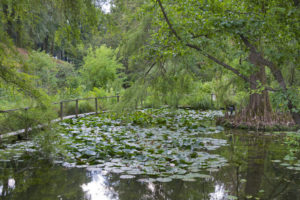
What kinds of pond algae are out there and how are they typically removed?
No one likes to see their beautiful backyard pond turn green and slimy from an abundance of algae. You may think that it’s too difficult to remove all of the algae, especially when trying to avoid harming fish, but there are a few methods for getting pond algae under control. Continue reading to learn more about pond algae and how the licensed aquatics experts at Scientific Plant Services can help remove it!
Types Of Pond Algae
First, it’s important to understand the different types of pond algae before you try to remove anything. “Algae” doesn’t refer to a particular type of plant, but instead refers to all of the various types. For example, some algae are microscopic, while others can be up to 100 feet long. Your pond is likely to have a selection of different algae, including phytoplanktonic, blanketweed and string algae, and blue-green cyanobacteria.
Planktonic Algae
Phytoplanktonic algae are free-floating and are the most common type of this algae. It can sometimes be confused with muddy water as it causes the water to look green, brown or reddish in color. It is relatively easy to remove with chemical methods, but if conditions are favorable for algae growth, several applications per year may be needed.
Filamentous Algae
Different species of filamentous algae exist, but all have a similar growth habit. These algae begin growth in the winter and early spring on the pond bottom. Single cells reproduce and join together into long hairlike strands or colonies that grow toward the water surface. By mid-summer, these strands form large mats that trap gases and float to the surface. When used carefully according to label instructions, aquatic herbicides can be safe and effective management tools.
Blue-Green Cyanobacteria
The third type of algae called blue-green cyanobacteria is too small to see until it reproduces and grows into a bloom. You may see it as blue-green or brown masses in the water. Unlike other types of algae, this type forms a blanket of slime on the surface of a body of water, and if it grows enough, it can completely block out sunlight. It is essential to remove blue-green cyanobacteria, as it produces toxins and can be harmful to fish and other animals. To prevent it from occurring in your pond, be sure to avoid overfeeding fish and birds, plant and maintain native flora around the pond, and do not overuse lawn and garden fertilizers near the water. If you need an effective pond algae control program, call Scientific Plant Services today!
Scientific Plant Service Is Your Go-To Source In Landscape Healthcare
Scientific Plant Service, located in Baltimore, is a privately-owned corporation, chartered in Maryland in 1957 by Frank J. Burke. We started as a full-service Arborist specializing in the care of shade trees and ornamental shrubs, but today we are a lawn and total landscape care company that is a huge part of the community. From aquatic environments and snow management to deer and mole control, SPS has services tailored specifically for your lawn and landscape.
We offer services in Maryland, Washington DC, and Virginia, including Harford, Baltimore, Carroll, Frederick, Howard, Anne Arundel, Montgomery, Prince Georges, Talbot, Queen Anne’s, and Calvert counties in MD, as well as Loudoun County, Fairfax County, Arlington, Alexandria, and Falls Church in VA. For more information, contact us online, or call us at 410-321-0970. Be sure to follow us on Facebook, Twitter, LinkedIn, and Pinterest!

